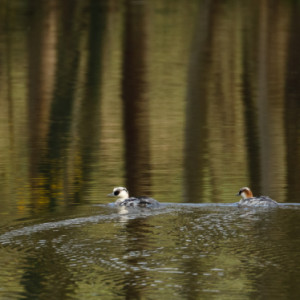Seasonal
I've been resisting Christmas. But today I bowed to the inevitable and put up the first two decorations, which are always the wreath on the front door, and an Advent light in the sitting room window. So I may as well go the whole hog and post a fluffy robin as well, singing its little heart out in the show garden at Hillers, when I stopped there for coffee and a few minutes in their bird hide, on my way back towards home from a duck hunt.
I've put another shot from Hillers on my Facebook page - it's not as well-focused because I was a long way away from it and the light in the woodland was dire, but I was pleased (after much trying) to get a clear enough shot to show that the grey wagtail was catching rat-tailed maggots for its supper. These are the larvae of certain species of hoverfly such as Eristalis tenax, which develop in pools or wet soil, and breathe through a long flexible tube attached to their rear end. The wagtail kept going rather gingerly down the quite steep sides of the concrete pool near the bird hide, picking the larvae out of the shallows, and then retreating to a log, against which it would beat them until they were mashed enough to eat. I couldn't get enough shutter speed to capture the tenderising process, you may be relieved to hear.
And now, a little quiz. Is Smew:
1. A minor character in a Charles Dickens novel - a sly and manipulative solicitor's clerk, who's secretly in love with the heroine, but much too grubby and unimportant ever to hope to win her hand?
2. Something unpleasant that you'd rather not be caught producing?
Dear Jocasta,
Thank you so much for the party - the company was fab, and nibbles were wonderful! I really must apologise once again for the smew on the carpet - you were so gracious about it (even when I poured white wine over it to try to stop the stain setting!), but I'm truly mortified. When you've had it cleaned, please do send me the bill, and I'll reimburse you immediately.
Fondest love!
3. A small diving duck, related to the mergansers and goldeneyes, native to continental Europe, but found in small numbers in the UK each winter; the females and immatures being known as redheads, and the spectacular adult males as white nuns?
For the answer, please see my extra photo. These are both first winter males - big brother on the left (further into his grown-up plumage), and little bro on the right. It's really only a record shot, but I wasn't sure how flighty they might be, so I kept a decent distance away from them.


Comments
Sign in or get an account to comment.


